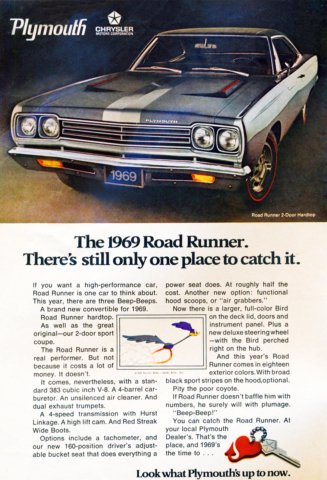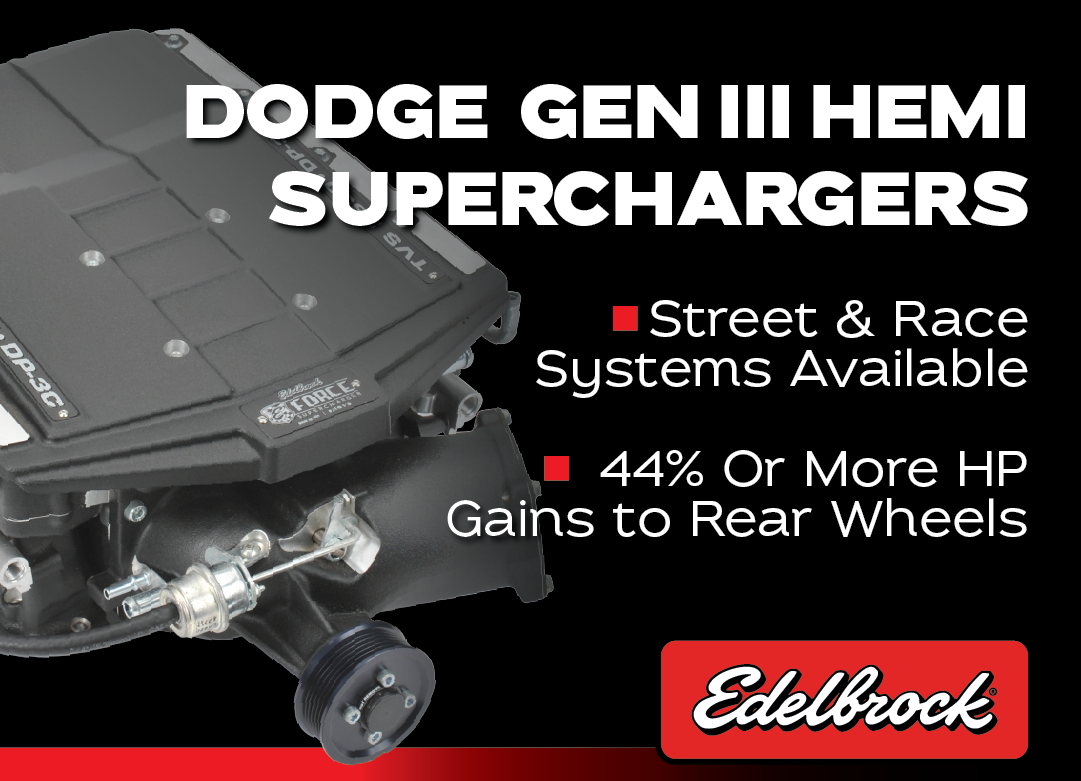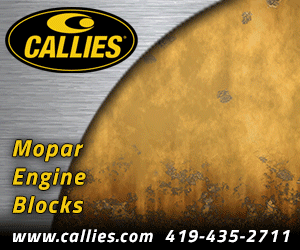 Road Runner. For many, those words recall images of Saturday mornings seated in front of the TV eagerly observing a lean, speedy bird christened the “Road Runner” continually outsmarting an incompetent coyote known as “Wile E. Coyote.”
Road Runner. For many, those words recall images of Saturday mornings seated in front of the TV eagerly observing a lean, speedy bird christened the “Road Runner” continually outsmarting an incompetent coyote known as “Wile E. Coyote.”
In the mid- ‘60s, Chrysler’s brass developed a concept of building a stripped-down, low-cost car with a large engine and 4-speed transmission to attract the youth market buyers, and the Road Runner character embodied everything the vehicle should be. Chrysler Corporation paid $50,000 to Warner Brothers for the use of the Road Runner name and likeness for the marketing of the all-new ’68 Plymouth b-body.
With positive sales numbers for the ’68 Road Runner (almost 45,000 units sold), Plymouth kept the same low-cost “taxi cab” formula for the ’69 model, as described in the November 1968 Playboy magazine advertisement. The 383 Super Commando remained the stock engine with optional engine choices of a 426 Hemi or a 440 6bbl (a mid-year addition). A few changes were made to the Road Runner for ‘69.
It received a minor front end facelift, and the taillights were modified slightly. There were changes to the graphics and the side markers, and the ’69 Road Runner could be ordered with bucket seats. The only significant difference was a Hurst Performance shifter replacing the Inland unit of the previous year. The popularity of the ’69 Road Runner nearly doubled the ’68 sales total. So impressive was the overall Road Runner concept and sales numbers that Motor Trend magazine named it the Car of the Year for 1969.
 Why did Plymouth switch to a Hurst shifter? The Inland shifter was great for everyday driving, but when the time came for a power shift, the Inland provided loose, sloppy long throws. In contrast, the Hurst shifter was tight during power shifts and had a short, smooth, and precise throw. Hurst had a significant advantage, known as the Syncro/Loc feature. The Syncro/Loc design had a bolt through a lock nut on the front and rear of the shifter housing.
Why did Plymouth switch to a Hurst shifter? The Inland shifter was great for everyday driving, but when the time came for a power shift, the Inland provided loose, sloppy long throws. In contrast, the Hurst shifter was tight during power shifts and had a short, smooth, and precise throw. Hurst had a significant advantage, known as the Syncro/Loc feature. The Syncro/Loc design had a bolt through a lock nut on the front and rear of the shifter housing.
The bolts, once correctly adjusted in the nut, restricted the distance the shifter traveled, which, in turn, limited the range the shift rods traveled. This prevented overextending a shift rod, which could have led to broken shift forks, split blocker rings, and bent shift rods. By having confidence in its quality, Hurst coined the catchphrase, “shift as hard as you please, but don’t break your arm.”
Hurst Performance Inc. was founded by George Hurst in 1958. A Hurst shifter was an OEM piece in many muscle-car era Mopars, including the L023 Hemi Darts and Barracudas. When money was on the line, the pros (and enthusiasts) reached for a Hurst shifter to put them in the winner’s circle. Over the years, the Hurst corporation expanded its performance and safety products. Concerned about race car driver extraction after an accident, George Hurst and his engineers invented the Hurst Jaws of Life®.
Hurst, now a Holley company, continues to develop industry-leading products, including its Elite Series line of performance products. This line includes exhaust systems, wheels, suspension springs, automatic floor shifters, and, of course, the world-famous manual transmission shifters for muscle cars, old and new. So, although the ’69 Road Runner was the Car of the Year, the Hurst shifter, as shown in the February 1969 Hot Rod advertisement, is the shifter of a lifetime.







